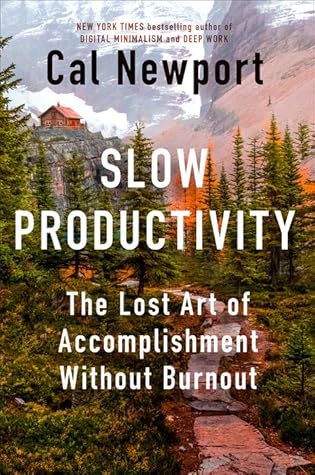More on this book
Community
Kindle Notes & Highlights
The relentless overload that’s wearing us down is generated by a belief that “good” work requires increasing busyness—faster responses to email and chats, more meetings, more tasks, more hours.
SLOW PRODUCTIVITY A philosophy for organizing knowledge work efforts in a sustainable and meaningful manner, based on the following three principles: 1. Do fewer things. 2. Work at a natural pace. 3. Obsess over quality.
this philosophy rejects busyness, seeing overload as an obstacle to producing results that matter, not a badge of pride. It also posits that professional efforts should unfold at a more varied and humane pace, with hard periods counterbalanced by relaxation at many different timescales, and that a focus on impressive quality, not performative activity, should underpin everything.
PSEUDO-PRODUCTIVITY The use of visible activity as the primary means of approximating actual productive effort.
It seems like the benefits of technology have created the ability to stack more into our day and onto our schedules than we have the capacity to handle while maintaining a level of quality which makes the things worth doing. . . . I think that’s where the burnout really hurts—when you want to care about something but you’re removed from the capacity to do the thing or do it properly and give it your passion and full attention and creativity because you’re expected to do so many other things.
“Those who suffer for others do more damage to humanity than those who enjoy themselves,” Petrini explained.
KNOWLEDGE WORK (GENERAL DEFINITION) The economic activity in which knowledge is transformed into an artifact with market value through the application of cognitive effort.
A philosophy for organizing knowledge work efforts in a sustainable and meaningful manner, based on the following three principles: 1. Do fewer things. 2. Work at a natural pace. 3. Obsess over quality.
PRINCIPLE #1: DO FEWER THINGS Strive to reduce your obligations to the point where you can easily imagine accomplishing them with time to spare. Leverage this reduced load to more fully embrace and advance the small number of projects that matter most.
In knowledge work, when you agree to a new commitment, be it a minor task or a large project, it brings with it a certain amount of ongoing administrative overhead: back-and-forth email threads needed to gather information, for example, or meetings scheduled to synchronize with your collaborators. This overhead tax activates as soon as you take on a new responsibility.
An anonymous senior consultant told me about how his career turned around when his company put in place a policy that gave its consultants allotments of nonbillable hours that they could use for whatever they wanted. “This has been life changing,” he explained. “I was able to learn and branch out into new areas . . . it reengaged me in the field . . . it has reminded me why I enjoy all this in the first place.”
We’ve arrived at the smallest scale of work that we’ll consider for our limiting strategies: the projects you decide to make progress on during the current day. My recommendation here is simple: work on at most one project per day.
I used to frequently recommend an organizational strategy called an autopilot schedule. The idea was to assign regularly occurring classwork to specific times on specific days, and sometimes even specific locations, each week. Maybe you always do your English lit reading after your 10:00 a.m. class on Tuesdays and Thursdays, using the same table, on the same floor of the same nearby library. This strategy worked because it countered many students’ default tendency to work only on what was urgently due.
A key refinement to support this task-centric version of autopilot scheduling is to leverage rituals and locations. If you can connect a regularly recurring task block to a specific location, perhaps paired with a little ritual that helps initiate your efforts, you’re more likely to fall into a regular rhythm of accomplishing this work.


